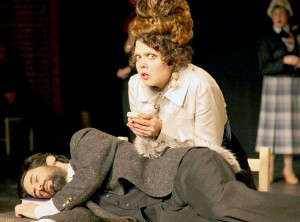Track 3 adds music and dance to Chekhov’s classic
Anton Chekhov most likely never imagined that his play Three Sisters would still be performed in 2013 — not to mention with the addition of elements such as barbershop quartets and disco music.

Jazz hands · Irena, one of the three sisters in Track 3, is played by Caitlyn Conlin, a soprano who has a background in jazz music. She brings her vocal range to the play’s various musical numbers. – Courtesy of Richard Alger
He might be rolling in his grave, but the Theatre Movement Bazaar has put together a newly imagined performance of Chekhov’s characters, entitled Track 3, currently playing at the Bootleg Theater. The show seamlessly integrates original text and new dialogue, as well as song and dance numbers to create a riff on Chekhov’s timeless story.
Track 3 tells the watered-down story of three sisters, Olga (Kendra Chell), Irina (Caitlyn Conlin) and Masha (Dylan Jones). Their father died a year ago in the story, and they still struggle with living in the small town their parents forced them to move to. All they dream of is moving back to the cosmopolitan center of Moscow. Eventually, their brother, Andrei (Mark Skeens) is introduced, along with his wife Natasha (Liz Vital), who wants to take over the family home of the sisters. The 90-minute production follows the sisters and their interactions with Andrei, Natasha and their soldier friends as the sisters come to terms with what their life has become.
This extremely creative production does a fine job of communicating the basic story of the original play while still adding its own artistic flair. Made obvious by its name, Track 3 is based primarily on movement. Though the story follows the original text, the production includes interludes of stylized movements, musical numbers and dances. The director and choreographer, Tina Kronis, has no limit to the direction she takes the movement: The play incorporates everything from a barbershop quartet to disco music.
The show opens with the three sisters standing in a triangular shape at the front of the playing space. They take turns leaning toward each other, slowly moving through various poses and effectively convincing the audience that these are not normal people. They appear strange and socially awkward, as their obsession with moving back to Moscow takes over their entire beings.
A particularly fun moment involves the actors becoming a Russian band for a short scene and, just as quickly, abandoning their accordions, guitars, cymbals and wind instruments. Another number features a choreographed dance around the tables complete with singing, dancing, confetti-throwing, music and strobe lights. These moments are oddly fascinating and unpredictable, as each creative choice surprises the audience. The actors employ such a wide range of movement and music that they remain entertaining throughout the show and never seem contrite.
This piece revolves around not only movement, but also a sense of an ensemble. All of the actors share a similar load of stage time and responsibilities as they work together to create the various musical moments. Members of the ensemble do an excellent job of establishing and communicating their characters through minimal dialogue, relying instead on body language and subtle looks.
The complicated movement is complemented with a minimalist set, which comprises only tables, chairs and a stand-alone fireplace mantle. The actors often incorporate the set into their routines, moving the tables in a synchronized dance. The production also does not use any backstage space; instead, the actors sit in chairs against the wall of the stage, completely exposed to the audience as they await their entrance.
When an actor has a costume change, the rest of the ensemble stands around him while he or she changes. This adds to the creative nature of the production and makes the space very intimate, allowing the audience to feel a stronger connection to the performance.
Though most of the costumes are practical, modern-day outfits, the three sisters each feature an odd headpiece. A combination of feathers, hair, fabric and other materials, the headpieces gives them a bird-like, hoarder look, reminiscent of the women of Grey Gardens. One of these tall hats comes with a long raccoon-like tail, another with dog-ear-like tufts of hair and yet another with stacks of different colored hair. The rest of their outfits are fairly normal, but these elements bring the production further into the absurd and nicely complement the actors’ odd movements.
Though this play is strange, unique and crazy at times, the characters are still true to the emotions of these poor sisters. If nothing else, it allows the actors to explore the emotions more fully by communicating them through movement and song. At the end of the play, when the sisters each come to their own conclusions about their lives, it is shocking that this silly bunch of actors are able to portray such somber moments well.
Track 3 is a wonderfully creative show, if not a bit wacky. The Theater Movement Bazaar’s interpretation of the text is fascinating and makes for a very enjoyable evening of theater.
Track 3 plays through Feb. 10 at the Bootleg Theater in Los Angeles.
